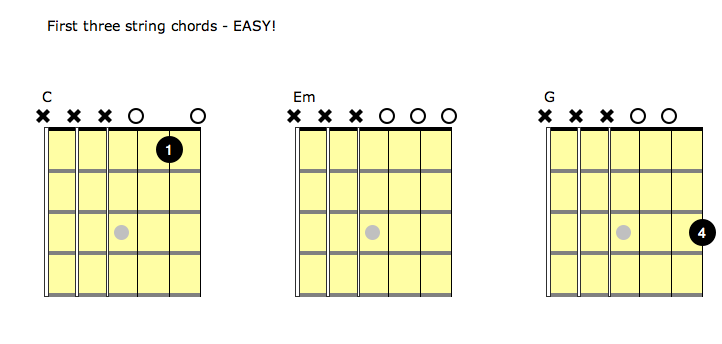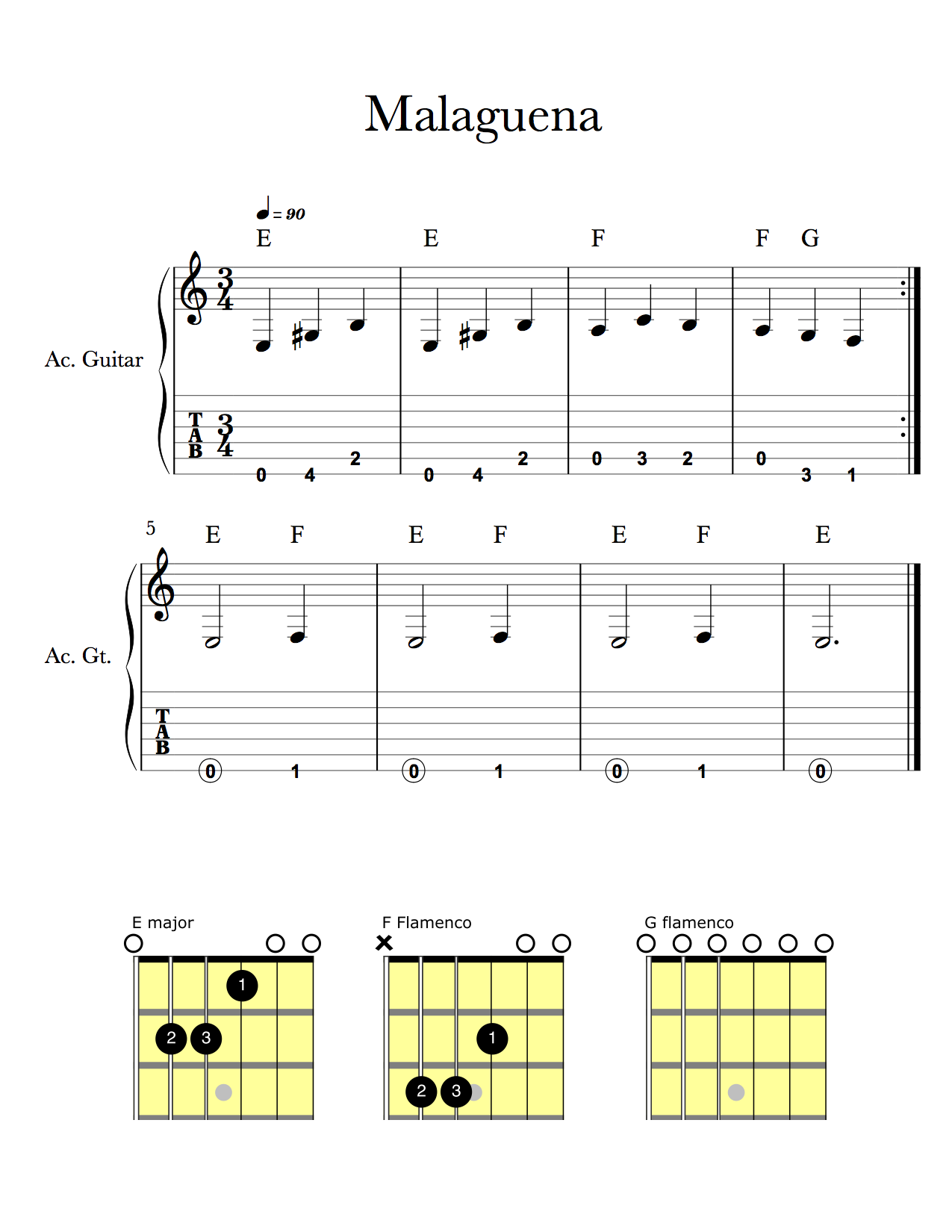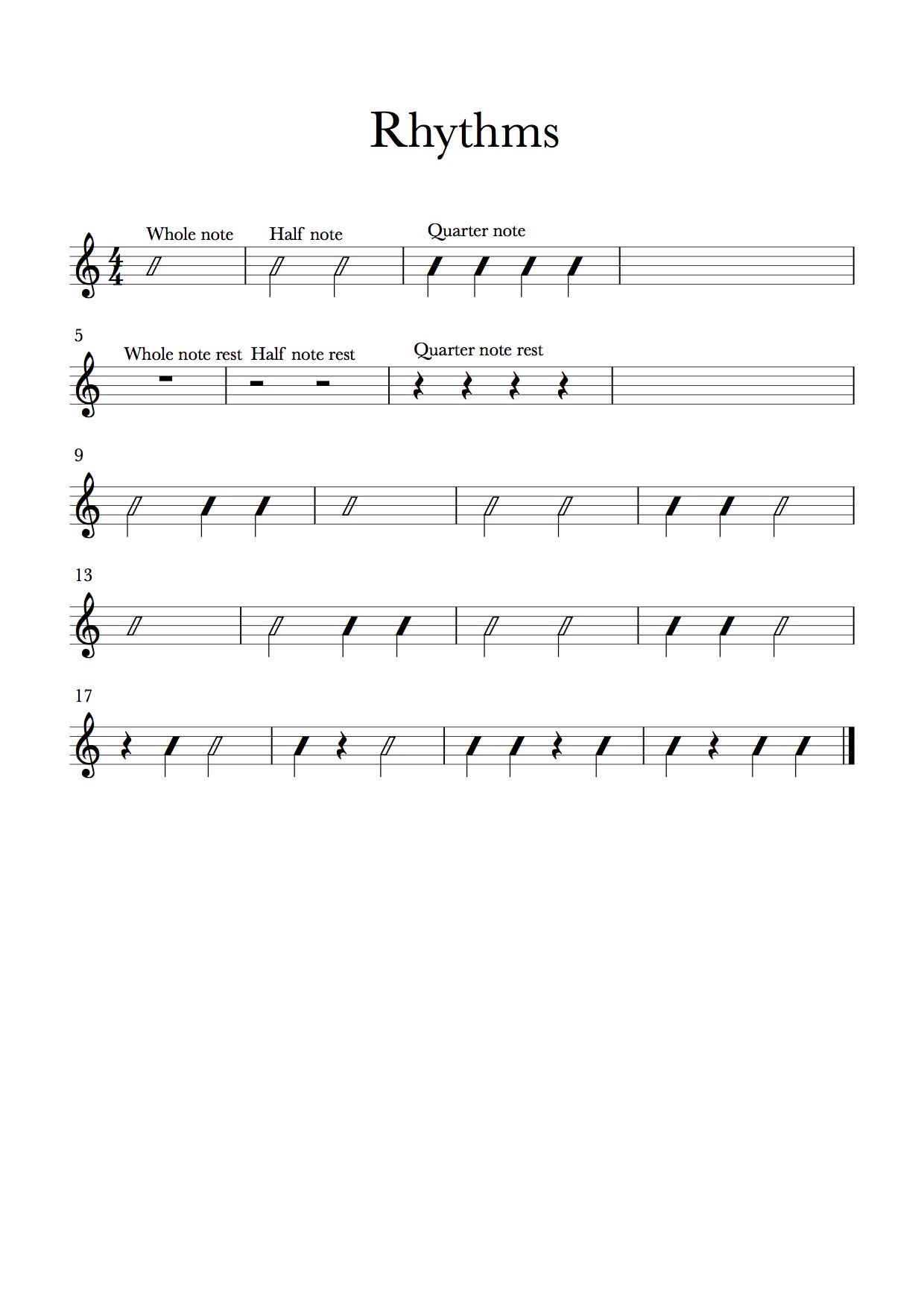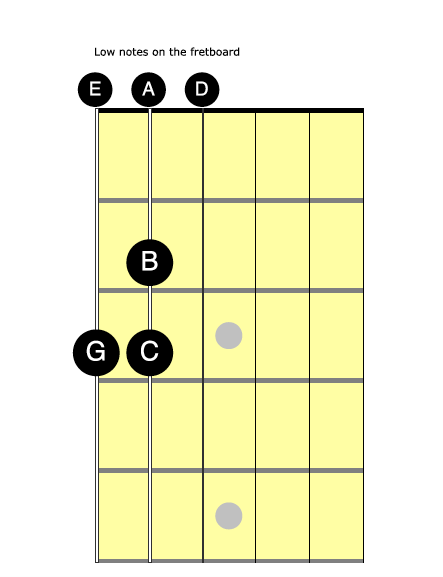Malaguena
This is a lively, atmospheric Spanish melody. Do you recognise any of the notes it uses?
Go slow even if you’re desperate to go fast and when it’s easy, you can pick each note twice (down and up). If you were playing the chords, or the half size chords (remember when you put the brackets around the thinnest three strings?) then spend a minute or two moving between the E and F chord. If you didn’t play the melody here, have a shot at the first line – it’s on the thickest string (6th) and next thickest (5th).
Use finger 3 for the 4th fret on string 6 (ceiling) and finger 1 for the 2nd fret on string 5. What do you think would be good choices for the third bar?
Lesson Nine
Review Under The Sea and chord changes from A to E and A to D. We also looked at a blues boogie. If you played a D chord for the first time today, play the D chord four times when you practice at home, releasing your fingers and finding the shape again each time.
For the Blues boogie, go through this little list:
Play A boogie/easy chord x 4
Play D boogie/easy chord x 4
Play E boogie/easy chord x 4
Now play A boogie or easy chord x 2
Play D x 2
Play E x 2
Play A x 1, then D x 1, then E x 1.
Lesson Eight
Under the Sea. This is an upbeat tune that uses open strings or three string chords. To play it fluently, do 1 min changes between either the A string and the D string or the A chord and the D chord. If you’ve run out of 1 min change spaces, I’ll put a downloadable blank copy up. Here’s an extract of the first part of the tune.
Lesson Seven
Well done! This week I want you to do your one minute chord changes like we do in the session for G to C. Most of you are already past ten changes in a minute. When you get to twenty, you’ll see it gets so much easier to play all sorts of songs. If I gave you the D chord already, add the chord change D to G and D to C in. Count out the chords to I gotta feeling as we did in the session a few goes round before putting the chords in-you’ll see it gets easier to keep your place when you do this. Don’t worry though if you still lose your place sometimes-this always happens to begin with, and you can just jump back in when the song goes back to the start of the sequence. The audio for that is already below.
Lesson 6!
You’ve completed six guitar lessons and you’ve learned a whole lot of things. There’s no class this Saturday, but I’d like you to have a shot at the chord game. Do 1 min of changes between chords G to C and when you’ve done that, have another go at playing I Gotta Feeling along with the audios below. You’re probably now almost playing it full speed. There are two versions below, one slower for you to start with and one quicker.
Before playing it with your guitar, count it out like we do in class with the chords. So – G 2 3 4, 1 2 3 4, C 2 3 4, 1 2 3 4 and so on. This will make it a lot easier to stay in time when you are playing chords.
If this is going well, you can put the additional down strums in. And don’t forget Down In the Jungle! Take this opportunity to review the How To Read Tab video and play through Green Onions too as we’ll be playing that again.
Click on the image to the right to see some of the whole, half and quarter notes and rests (remember rests are silences that last the same amount of time as their corresponding note). It might need two clicks to show up full size.
Well done on lesson five. We’ve learned quite a few things already: the names of the open strings (need a reminder? Thick to thin = E A D G B E. ‘Eddie Ate Dynamite, Good-Bye Eddie’ is a good way to remember). We’ve learned some note durations and some counting. We’ve learned some chords. This week we’ve also learned how to read music for guitar when it’s written down, using tab. To get the most out of playing at home, this is what you should do: Make sure you know how to play chords G, Em and C. Review the video from lesson 3 called ‘First chords’ if you can’t quite remember them. See how many times you can move between G and C in a minute. If you do this every day, you will get faster very quickly.
Write it down like this: Day Number of chord changes
1 4 changes (or however many you get)
2 8 changes
3 12 changes.
See if you can play through Green Onions again – paying particular attention to the last part where it moves strings each bar.
Also, see if you can play the chords to I Gotta Feeling like we started in lesson four.
Tip: Click on the corner to expand this video so you can see it properly.
Well done on your fourth lesson! Today we learned some new low notes on the fretboards, and we distinguished between a low note (one note on its own, on the fat strings), and a chord (three notes together, the thinnest strings).
We also played the notes and chords as a sequence.
To play at home, here are two games:
-
Take a G chord and a C chord and see how many times you can change between them in one minute. Do this every day and write it down and you’ll see the number go up. Some people manage to get to twenty changes in a week! Perhaps you’ll be one of them.
-
Play these low notes: C, A, D, G, E, B, G, D, A. See if you can ask someone to call them out to you and find them without referring to your piece of paper. You already know E A and D because they are the open strings.
-
Then see if you can play the chord sequence from the song I Gotta Feeling – the audio is right below in last week’s section.
Well done on your third lesson! We review the names of the notes and filled in the three thinnest strings – so from thick to thin, the strings are called E A D G B E. Some people like to use a phrase to remember them, like Eddie Ate Dynamite, Good Bye Eddie. Can you think of one?
We also reviewed note lengths – whole notes last for four, half notes for two and quarter notes for one. AND! We learned some new chords. This short video will help you practice the new chords.

When you’ve reviewed the chords, try playing them in this order, counting for four beats on each one:
| G | G | C | C |
| Em | Em | C | C |
This is the same as the song I Gotta Feeling that we heard at the end. You can listen to it here again:
We’ll get used to playing along with it next week, the original goes quite fast but we can also slow it down. The first clip right here is the original, the bottom clip is slower.
Well done on session two! We’re going to stick with the material from last week, audios etc below, but this time at home see if you can do a game where you set a timer for one minute and see how many times you can switch between playing one note on the A string and one note on the E string. Then try it for the D string and the A string. Play each note with a downstroke with your pick.
Well done on your first session! You did a great job. Here is a reminder of our objectives for Saturday’s session and some audio guides to help you play at home.
Objectives: Learn the names of strings E, A, D
E is the thickest string (string number six)
A is the next thickest string (string number five)
D is the next thickest string (string number four)
Use these notes to play Down in the jungle with open strings E A D.
How to play this at home: use these audios attached to help you remember which string is which. Make sure your guitar is tuned first.
Here is a warm up game to help you remember the strings – press play, and you’ll hear my voice calling out different string names. You just have to find and play that string as quickly as you can. I’ll start slowly and then it’ll get a bit quicker. You can always pause it the first time you do it if you need a bit more time to remember which string is which.
When you’ve done that, have a go at playing Down in the jungle. There’s a little reminder of how to play it here:
If you feel like you really know it well and you want to sing along or play along with me, try playing along to this one.
If you can’t remember how it goes, here’s a copy of the words and the notes:
Down in the jungle
A A D E
Down in the jungle where nobody goes
A A D E
There’s a big fat gorilla picking his nose
A A D E
He picks it, he flicks it, to see where it goes
E E
Who’s going to get that,
E E
Who’s going to get that,
E E
Who’s going to get that
E A
Slimey Snot
Play it first just using the low notes A, D and E (which are the open strings 5,4 and 6 as you know).
Well done on your first session! You did a great job. Here is a reminder of our objectives for Saturday’s session and some audio guides to help you play at home.
Objectives: Learn the names of strings E, A, D
E is the thickest string (string number six)
A is the next thickest string (string number five)
D is the next thickest string (string number four)
Use these notes to play Down in the jungle with open strings E A D.
How to play this at home: use these audios attached to help you remember which string is which. Make sure your guitar is tuned first.
Here is a warm up game to help you remember the strings – press play, and you’ll hear my voice calling out different string names. You just have to find and play that string as quickly as you can. I’ll start slowly and then it’ll get a bit quicker. You can always pause it the first time you do it if you need a bit more time to remember which string is which.
When you’ve done that, have a go at playing Down in the jungle. There’s a little reminder of how to play it here:
If you feel like you really know it well and you want to sing along or play along with me, try playing along to this one.
If you can’t remember how it goes, here’s a copy of the words and the notes:
Down in the jungle
A A D E
Down in the jungle where nobody goes
A A D E
There’s a big fat gorilla picking his nose
A A D E
He picks it, he flicks it, to see where it goes
E E
Who’s going to get that,
E E
Who’s going to get that,
E E
Who’s going to get that
E A
Slimey Snot
Play it first just using the low notes A, D and E (which are the open strings 5,4 and 6 as you know).


